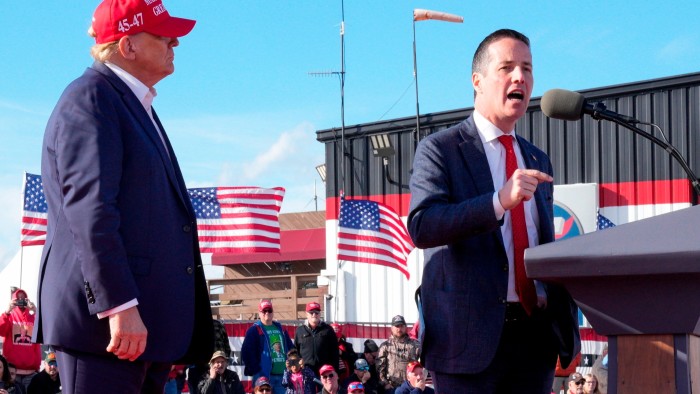Good morning. Looks like it’s the season of pulling petals from a flower and going “loves me, loves me not” as far as the trade deal with the US is going. Last week, Donald Trump sounded like he was warming up to signing a deal, while his commerce secretary Howard Lutnick seemed to suggest otherwise. Meanwhile, the EU and India are closer to a deal, despite Trump’s efforts at influencing it.
Before we get started, a big thank you to my colleagues Krishn Kaushik and Chris Kay for stepping in for me while I traipsed around Belgrade. Two highlights: staying at the Belgrade waterfront on the banks of the river Sava turned out to be a great choice, and Gušti Mora, a seafood restaurant featured in the Michelin guide was so good that I ate there twice. (Bonus photo with Serbian poet, painter and bohemian Đura Jakšić at the bottom).
Tech trouble
India’s tech sector, which had thus far dodged a bullet from Trump’s tariffs, is now under threat from newly proposed US legislation. The Halting International Relocation of Employment (HIRE) Act 2025 seeks to impose a 25 per cent tax on American companies for payments made to foreign workers for services that are consumed in the US. It also prohibits businesses from using these payments as tax deductible expenses. If passed, the bill will in effect negate most of the cost benefits that make outsourcing technology services to India a viable proposition, and will affect the prospects of both IT outsourcers such as TCS and Infosys as well as the now-booming business of global capability centres or GCCs.
The US generates more than half the revenues for most Indian leading tech companies. The HIRE Act adds to the already muddied waters of H1B visas, which these companies rely on to move talent from India to the US. Trump has called for a massive overhaul of the current system for H1Bs, and his commerce secretary Howard Lutnick has termed the visa category as a massive “scam”.
It is early days, and the bill still has to pass through the US Congress and be signed by the president. Indian analysts and industry experts point to past failed efforts at similar legislation and seek comfort in the fact that in its present form, the bill is unlikely to pass. However, the current political situation in the US is unlike anything the 30-year-old Indian outsourcing industry has seen. The Maga base has been vociferously complaining about the number of Indians in the tech sector in the US and the group’s influence on the current administration should not be underestimated.
At the government level, India has been trying to make its case as a good faith trading partner. Earlier this year, the finance ministry scrapped the 6 per cent levy on online advertisements, popularly known as the “Google tax”. But for now, none of that seems to have worked. While last week’s rhetoric from the US administration suggests a trade deal between the two countries will happen, there is no telling what it will entail and whether there will be carve-outs for specific sectors. Besides, if we can say one thing with certainty about the Trump administration, it is that even its best deals are written in water and susceptible to constant changes.
For all these reasons, India’s tech sector should not dismiss the HIRE Act as an impossibility. The business landscape for these companies in the US is increasingly a hostile one. The wise move will be to account for it and strategise a way to negate its impact on revenues and profits. While pivoting to other geographies is a good idea for diversification, it is unlikely to bear fruit immediately. But this is also a transformational moment for all business operations as AI applications take over. India’s tech sector should use this opportunity to reconfigure its offerings, move up the value chain and race ahead in helping its clients use the new technology more effectively.
What strategies should the Indian IT sector incorporate? Send us your thoughts. Hit reply or email us at indiabrief@ft.com
Recommended stories
-
US companies are on a hiring slowdown after Donald Trump’s tariffs hit.
-
India’s push for an EU trade deal has been hit by a dispute over basmati rice.
-
Pakistan is battling the resurgent opium trade.
-
The rise of the western refugee: “It might soon be rich-world citizens who flee political chaos,” writes Janan Ganesh.
-
Jay Rayner reviews Apna Punjab: A tiny Southall restaurant, whose chef feeds Bollywood.
Open markets
India’s stock market regulator has unleashed a slew of reforms to improve the quality of offerings in the financial markets. It has relaxed the rules on minimum public offer for IPOs, reclassified real estate investment trusts (Reit) as equity in order to widen the investor base, and reduced the exit loads mutual funds can charge from 5 to 3 per cent. These decisions, taken during the securities and exchanges board of India’s (Sebi) meeting on Friday, are expected to broaden the investing base of mutual funds and improve the quality of investible assets in the market.
Sebi’s decision to reduce the minimum public offer from 5 to 2.5 per cent for big IPOs will help accelerate some major listings the markets have been expecting, starting with Jio, the telecommunications business of Mukesh Ambani-owned Reliance. At 5 per cent, the company’s huge valuation, which is estimated at between $130bn-$150bn, would have meant an IPO size that the Indian market might have been unable to absorb. The new rules also give big companies a longer timeline to meet the minimum public shareholding norms, allowing them up to 10 years to dilute stakes. Sebi has also simplified the compliance requirements for low-risk foreign investors such as sovereign wealth funds, global retail funds and central banks to invest in the Indian markets. This is significant considering foreign investors have withdrawn nearly $12bn so far this year from the equity and debt markets in India.
Sebi’s intent with these reforms is clear: it wants to attract better paper and better investors into the Indian markets. The Jane Street saga has been a cautionary tale for the Indian market regulator; volumes in the derivatives segment came at a steep cost. These new regulations are a more nuanced way of making the capital market attractive, both for companies seeking to raise money as well as for investors. It isn’t clear if these regulatory changes, too, are part of the efforts to reform the business landscape in India, spurred by the lack of a trade deal with the US. If yes, then we have something to thank Trump for.
What do you think of Sebi’s reforms? Hit reply or email me at indiabrief@ft.com
Go figure
The Gen Z revolution is spreading across Asia, and Nepal is just the most recent country to have seen the ruling elite toppled by frustrated young people. One of the primary drivers of their frustration is the lack of job opportunities.
My mantra
“One thing which I try to do is be a stickler for time. If things can’t be done within the time allotted, then obviously we are not being productive. An important element of productivity is to be sharp, both with the time you allot for meetings and what you accomplish during it.”
— Amitabh Chaudhry, chief executive, Axis Bank

Each week, we invite a successful business leader to tell us their mantra for work and life. Want to know what your boss is thinking? Nominate them by replying to indiabrief@ft.com
Quick question
Last week, Apple launched the iPhone Air, its thinnest phone ever. Are you rushing to the store? Tell us here.
Buzzer round
On Friday, we asked: What was the name of the failed plan hatched by an elderly media mogul, who partly inspired the HBO show Succession, to wrest future control of the family business empire from some of his children?
The answer is . . . Project Harmony!
Ram Teja was the first with the right answer, followed by Aniruddha Dutta. Congratulations!

I enjoyed walking around Belgrade, there’s a lot of history and great literary and scientific figures. (Too bad Djokovic lost the US Open to Alcaraz the day before I arrived. I did not realise so many of you were Djoko fans!) The food is splendid, especially if you eat meat, and last week the weather was just perfect — neither too hot nor too wet.
Thank you for reading. India Business Briefing is edited by Tee Zhuo. Please send feedback, suggestions (and gossip) to indiabrief@ft.com.
Source link











